Furcation Involvement Definition
Furcation Involvement
- Furcation involvement refers to the invasion of the bifurcation and trifurcation of multirooted teeth by periodontal disease.
Root Resection
- Root Resection is the surgical removal of all or a portion of the root before or after endodontic treatment.
Hemisection
- One root with its corresponding crown portion is cut and removed
Read And Learn More: Periodontics Question and Answers
Bicuspidisation
- The molar is cut without the removal of any part of the crown or root
Furcation Involvement Important Notes
1. Types of furcation
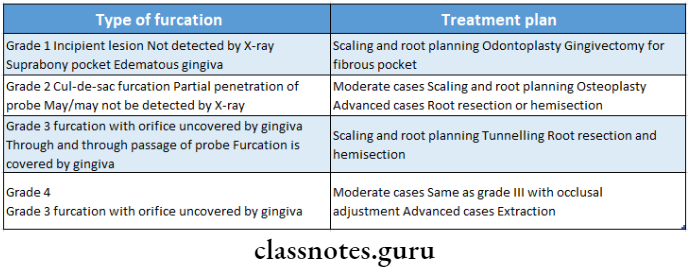
Furcation Involvement Long Essays
Question 1. Define and classify furcation. Enumerate treatment of grade III furcation areas.
Answer:
Furcation Definition:
- Furcation involvement refers to the invasion of the bifurcation and trifurcation of multirooted teeth by periodontal disease.
Classification of furcation:
1. According to Glickman:
- Grade 1
- Early/Incipient lesion
- Suprabony pocket
- Slight bone loss
- No radiographic changes
- Grade 2
- Bone destruction on one/more aspects
- But the portion of the bone is intact
- Cul-de-sac lesion
- A radiograph may or may not reveal the involvement
- Grade 3
- Complete inter-radicular bone loss
- No soft tissue loss
- Radiograph shows the radiolucent area between roots
- Grade 4
- Inter-radicular bone loss
- Gingival recession
- Radiolucent area radiographically
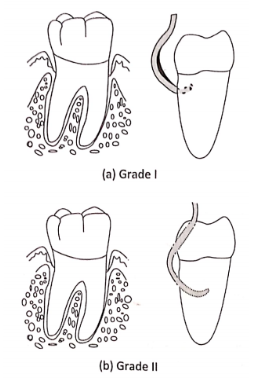
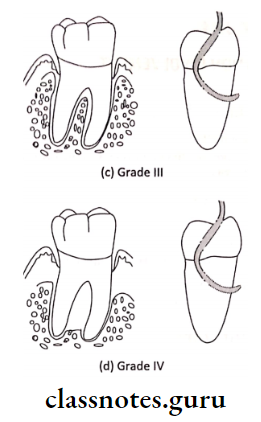
2. According to Tarnow & Fletcher:
- Subgroup A: Vertical bone loss upto 1/3rd of inter-radicular height (0-3 mm)
- Subgroup B: Vertical bone loss upto 2/3rd of inter-radicular height (4-7 mm)
- Subgroup C: Vertical bone loss beyond apical third (>7 mm)

Furcation Treatment:
Objectives:
- Facilitate maintenance
- Prevent further attachment loss
- Obliterate furcation defects
Furcation Treatment Options:
1. For grade 1
- Scaling and root planning
- Grade I can be accessible by scaling and root planning
- Curettage
- Done by Gracey curettes, Quetin furcation cu- rettes
- Gingivectomy
- It is the excision of the soft tissue wall
2. For grade 2
- Traditional methods
- Scaling and root planning- inaccessible areas
- Curettage
- Osteoplasty
- It involves shaping of bone to prevent plaque accumulation
- Hemisection
- It is the surgical removal of the root with the associated part of the crown
- Regenerative procedures
- GTR (Guided Tissue Regeneration)
- It involves the placement of membrane to prevent
- formation of long junctional epithelium
- Coronally repositioned flap
- Root conditioners
3. For Grade 3
- Tunneling
- Done in mandibular 1 molar due to better ac- accessibility
- It transforms Grades 2 to Grades 3 and 4
- Has increased risk of root caries
- So not used nowadays
- GTR
- Hemisection
4. For grade 4
- Extraction is done
Furcation Involvement Short Essays
Question 1. Root Resection.
Answer:
Root Resection Definition:
- Root Resection is the surgical removal of all or a portion of the root before or after endodontic treatment.
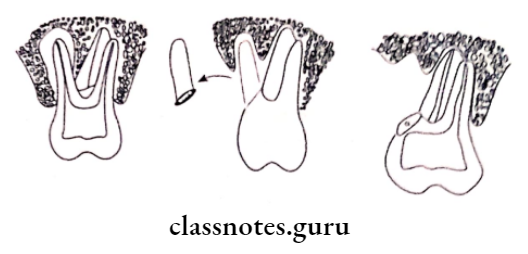
Root Resection Indication:
- Gingival recession
- Class 2 or 3 furcation
- Severe bone loss
Root Resection Contraindications:
1. Local:
- Poor oral hygiene
- Fused roots
- Endodontically untreated roots.
2. Systemic:
- Systemic diseases
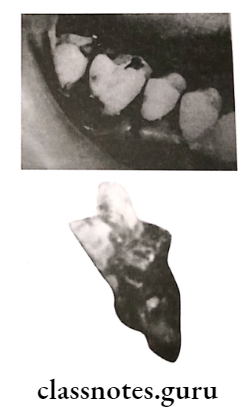
Root Resection Technique:
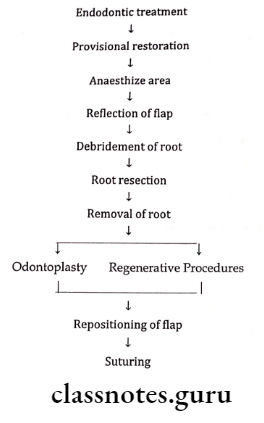
Furcation Involvement Short Question And Answers
Question 1. Grade 3 furcation involvement
Answer:
Grade 3 Furcation Involvement Features:
- Complete inter-radicular bone loss
- No soft tissue loss
- Radiograph shows the radiolucent area between roots
Grade 3 Furcation Involvement Treatment:
- Tunneling
- Done in mandibular I molar due to better accessibility
- It transforms Grades 2 to Grade 3 and 4
- Has increased risk of root caries
- So not used nowadays
- GTR
- It involves the placement of membrane to prevent for- motion of long junctional epithelium
- Hemisection
- It is the surgical removal of the root with the associated part of the crown
Question 2. Tunneling
Answer:
- Done in mandibular 1 molar due to better accessibility
- It transforms Grades 2 to Grades 3 and 4
- Has increased risk of root caries
- So not used nowadays
Question 3. Hemisection
Answer:
- It is the surgical removal of the root with the associated part of the crown
- Commonly performed on mandibular molars with buc- cal or lingual class 2 or 3 furcation
Hemisection Technique:

Furcation Involvement Viva Voce
- The most commonly performed root resection is disto- the buccal root of the maxillary first molar
- Furcation is most commonly involved in mandibular molars
- Least commonly involved in maxillary 1st premolars
- The prognosis is poor if the furcation areas are in- involved in maxillary 1st premolars
- Hemisection and bicuspidisation are suitable for mandibular molars
